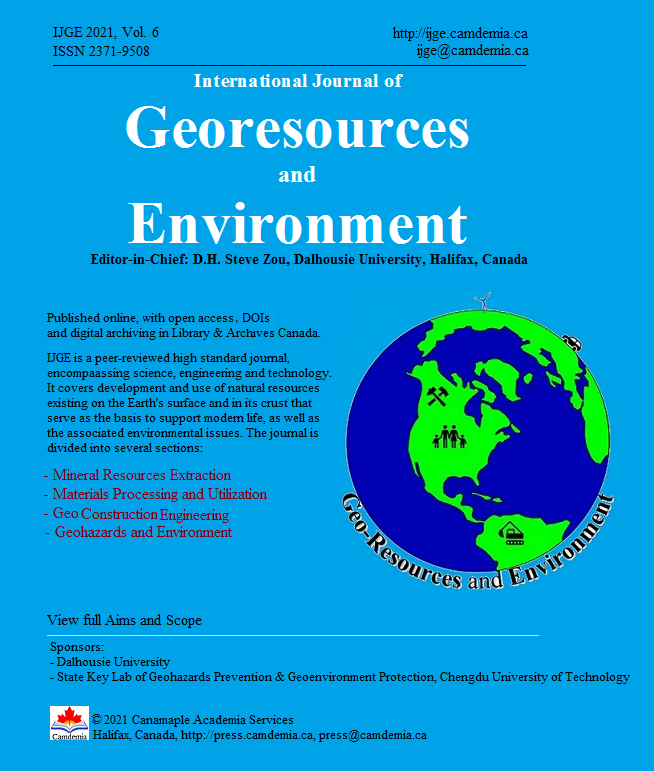Study of Flash Flood in the Rishiganga and Dhauliganga Catchment in Chamoli District of Uttarakhand, India
DOI:
https://doi.org/10.15273/ijge.2021.06.084Keywords:
Rishiganga, Glacier Snow Avalanche, Flash flood and Satellite dataAbstract
The present study is an attempt to investigate a flash flood that occurred on the morning of 7th February 2021 in the Rishiganga and Dhauliganga Catchments in Chamoli District of Uttarakhand. A catastrophic flood was triggered due to a massive rock-cum-snow avalanche caused by Antecedent Snow falls in the region. A huge flash flood was generated as a tremendous quantity of rockslide, comprising deposited ice and snowmelt, rolled down the Ronthi Glacier and flowed downstream into the glacier valley. This massive flash flood hit the NTPC's Tapovan-Vishnugad hydel project and the Rishiganga Hydel Project, bridges, roads, and communities in and around Raini, Tapovan and Joshimath regions in the Chamoli district of Uttarakhand. The mud and slush-inducing elements resulted in the development of a dammed lake, which momentarily blocked one of the Rishiganga's tributaries. Temporal satellite image has been used to access the information of disaster damage assessment in the region. The high-resolution satellite image clearly showing flash flood watermarks in the region and on the avalanches site rock outcrops reaching up to 50–130m height on the way to Raini Gaon. As part of our analysis, we have also looked at the valley's slope profile, which clearly shows the valley's height following the destruction. It is estimated that more than Rs 4,000 crore infrastructures loss due to this flash flood in the region. Besides, two bridges have also been lost. Hydometeriological analysis was also carried out in order to obtain the trend of rapid increase in temperature in the valley where disaster occurred. Using remote sensing (RS) and Geographic Information System (GIS) techniques, thematic layers were generated for obtaining information on the flash flood.
Downloads
Published
Issue
Section
License
Copyright, Terms and Conditions
The International Journal of Geohazards and Environment (the Journal) is published by Canamaple Academia Services (the Publisher) online with open access, under a Creative Commons Attribution-Noncommercial license (CC-BY-NC) (http://creativecommons.org/licenses/by-nc/4.0/). Authors (the Authors) submitting papers (the Work) for publication in the Journal automatically agree to the following terms and conditions.
1. Under the license (CC-BY-NC), Authors give permission for others to share and reuse the Work, as long as the original source and author(s) are properly cited (i.e. a complete bibliographic citation and link to the Journal website) and the material is not used for commercial purposes. Any sharing or reuse must however indicate the original CC-BY-NC license terms of the work.
2. Authors transfer and assign to the Publisher all copyright in and to the Work. However Authors retain all proprietary rights except the copyright, related to the Work and also retain the rights a) to use, reproduce, distribute, and publicly display the Work in any medium in connection with the Authors‘ academic and professional activities, such as teaching, presentations and lectures, b) to create derivative works from the Work and to make full use of the Work in future research and publications, c) to authorize others to make any non-commercial use of the Work, d) to make both the pre-published and final-published versions available online in institutional and/or disciplinary repositories or on their own websites with a citation and link to the original paper published in the Journal.
3. Authors warrant that the Work is their original work, it is not copied from anywhere or anyone else, they are totally responsible for the authenticity, originality, validity and accuracy, and the facts and views are their own, that the Work contains no matter which is defamatory or infringes any literary or proprietary rights, intellectual property rights, or any rights of privacy, and that the Work has not been simultaneously submitted to any other journals or publishers. Authors further agree that their manuscripts whether accepted or rejected will not be returned and the rejected manuscripts will be disposed at the journal editor's discretion.
Disclaimer: The Publisher, the Journal and the editors accept no responsibility for statements or opinions expressed by authors. Use of information and materials in the Journal is the sole responsibility of users.


